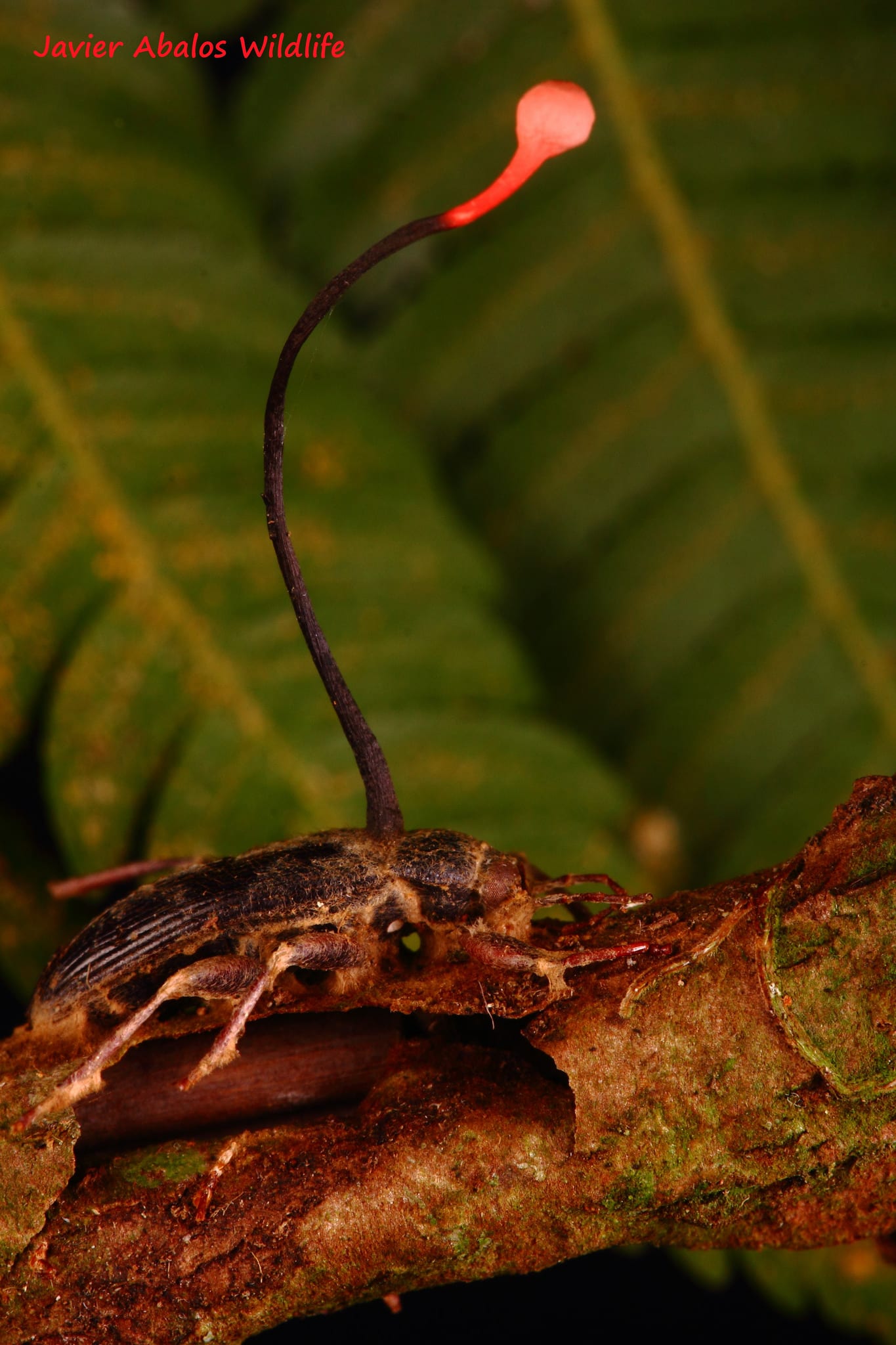Pretend for a moment you are a cockroach. Now, I don't want to go all Kafka on you, but bear with me. You are a beautiful species of cockroach in a tropical region of Africa, just living your daily life, out scrounging for some food when, all of the sudden, a bright turquoise wasp stings you right in your abdomen. As your legs become paralyzed, it stings you again – right in the head. Suddenly, you lose all free will and are led willingly by the wasp to its den like a dog on a leash.
Zombie Cockroaches
It sounds like something out of a zombie horror flick, but for cockroaches in tropical Asia and Africa, it is a common threat.
That wasp that just stung twice? She's a pregnant momma just trying to get food to her kids. When you put it that way, does it make her mom of the year? After stinging her cockroach prey twice, the adult wasp cuts off the antennae to drink the cockroach's hemolymph (aka roach blood).
She then grabs the cockroach's antennal stub and walks it to a pre-made nest site where she lays an egg on its body so her young can hatch out and eat the live cockroach. The cockroach remains alive for about 5 days before dying, and the wasp larva inside pupates and comes out as another roach-thirsty adult. See a video here.
What exactly happens in the brain of a cockroach to make it lose free will but still have the capacity to walk? To answer this question, we have to start with the cockroach brain. The cockroach brain is largely made up of two sections — one portion just above the esophagus and one just below (the supra-esophageal and the sub-esophageal ganglions). See that yellow tube in the diagram separating them? That's the esophagus of the insect. Imagine having a part of your brain below your mouth — insects do!
The other important component that all insects have is something called a pattern generator. This is a neural network that allows a male mantis to continue to mate or walk after his mate bites off his head. It is pretty similar to the reflex test your doctor will do when he hits your knee with a plastic mallet. Your knee should respond to the stimulus by jerking. In the same way, this pattern generator is able to maintain movement through repeated stimuli.
On a normal day for the cockroach, there is a very specific balance between neuronal input from both portions of the brain that tells this pattern generator whether the cockroach should be walking, running, or flying. When the emerald cockroach wasp stings the cockroach in its head, the wasp is able to hijack this precarious balance and anaesthetize the subesophageal ganglion, decreasing the cockroach's response to stimuli like spontaneous scattering to light. By tapping into this pathway, the wasp is able to control when and where the cockroach walks.
While this is an interesting story of insect zombiefication, it is only one out of many. Insect parasitoids are incredibly common — so common, in fact, that we think that parasitoid wasps may be the most diverse group of animals.
It's believed that there may be a distinct parasitoid species that attacks every single insect species — a pretty overwhelming number when you consider that 72.8% of the roughly 1 million species named are insects. Even more boggling, more and more hyperparasitoids are being discovered; that is, a parasitoid of a parasitoid. Maybe in a few years, you'll read a blog about the zombie parasitoid of the emerald cockroach wasp.
Zombie Ants

Insects aren't the only zombie-inducing life forms out there. Fungi do a pretty good job of taking over insect bodies, too. Fungi in the genus Ophiocordyceps are extremely common and use behavior-inducing strategies to enslave the ant and turn it into a spore-producing machine.
An innocent ant out foraging for its colony may pick up a spore that breaks into its body and commandeers its brain. This ant then clumsily crawls up to a height of approximately 25 centimeters and attaches itself to the underside of a leaf or a branch before a sexual body grows out of its head, exploding spores onto the ant colony below when the timing is right. Let David Attenborough's soothing voice lead you through the process.
When these ants first pick up spores, they all seem to do the same thing at the same time as if programmed, like soldiers under command. They tend to walk in the same direction, as if the fungus is working as a GPS, and the ants will orient themselves on leaves angled north-northwest. At noon, they sink their mandibles (ant teeth) into the leaf, and the sexual body of the fungi starts to grow. This location specificity provides the fungus with the perfect light and humidity to be most potent.
Fossils show leaves with tell-tale bite marks showing us this zombiefication has been developing and evolving for 48 million years.
Left unchecked, this fungus is so potent that it can take out entire colonies, which leads one to ask why this fungus hasn't wiped all ants out of existence. It turns out the zombie fungus has a zombie fungus of its own. A hyperparasite grows over the sexual body and sterilizes its spores, saving the ants below from the Ophiocordyceps spores raining down, in a similar manner to the hyperparasitoid wasps mentioned above. This is able to keep the system in check. In addition, some small insects, like gall midges in the family Cecidomyiidae, lay their eggs on the fruiting body to let their larvae eat the fungus growing on it.
Zombie…humans?
At this point, you're probably thinking that you're in the clear. The tension in your back is letting up a little because, frankly, the only examples of zombie behaviors seem to be in insects. Not so. Have you been introduced to the parasite Toxoplasma gondii? If you have a cat, you may already be veeery snuggly with it.
This single-celled parasite is the cause of a disease called Toxoplasmosis. The only definitive hosts of this parasite are felids, members of a family that includes house cats and their close relatives.
The life cycle works like this: a cat picks up a spore of the parasite, which then reproduces sexually inside the cat and produces more spores. These spores exit the cat via the cat's feces and become infective in 1-5 days. Go ahead and pause here and empty out that litter box you keep forgetting about before it becomes infective.
Humans can pick up the parasite by eating uncooked meat or drinking water that has been infected with cat feces, by receiving blood transfusions or organ transplants, and by vertical transmission from mother to baby. In intermediate secondary hosts (i.e., you and other warm-blooded animals) the parasite reproduces asexually, producing infectious forms of the parasite called bradyzoites. These bradyzoites can move to the brain and heart, among other tissues, where they can linger on for the human's lifetime.
It seems like the parasite would reach a dead end in some intermediate secondary hosts such as mice and rats, but the parasite has evolved a strategy to make its way back to the cat. The parasite is able to make the smell of cat urine attractive to infected rats. As a result, these infected rats are more easily found by cats while hanging around the odorous litter box. When the cat eats the rat, the parasite finally makes its way back into its sexual host.
Because of our close relationship to cats, Toxoplasmosis affects about 60 million individuals in the United States. In a few cases, it can cause increased risk-taking, including causing infected individuals to be 2.65 times more likely to be in a traffic accident.
Besides showing some increased risk in neurological disorders such as OCD, bipolar disorder, and Parkinson's, Toxoplasmosis has been potentially linked to Schizophrenia in over 38 studies.
In fact, recent research found that the T. gondii parasite can make a very similar protein to mammalian tyrosine hydroxylases which are the first step in converting the amino acid tyrosine to a neurotransmitter, dopamine. This would cause higher levels of dopamine in humans, a symptom commonly found in Schizophrenia and a possible cause of the correlation between the parasite and neurological disorder.
Due to its effect on the central nervous system, Toxoplasmosis may seem like a large concern to the population. But as up to half the world's population may have Toxoplasmosis, I'd worry more about the real zombie apocalypse.
About the Author
 Laura Kraft is a Georgia native, having grown up in Alpharetta, Georgia. She is a joint Bachelor's/Master's student studying aphid endosymbionts under Dr. Kerry Oliver, looking for a PhD program outside the southeast to move to. When not in lab, you'll find her at one of a couple Spanish conversation tables around Athens or improving her amateur photography skills. Laura Kraft is a Georgia native, having grown up in Alpharetta, Georgia. She is a joint Bachelor's/Master's student studying aphid endosymbionts under Dr. Kerry Oliver, looking for a PhD program outside the southeast to move to. When not in lab, you'll find her at one of a couple Spanish conversation tables around Athens or improving her amateur photography skills. |
About the Author
- athenssciencecafehttps://athensscienceobserver.com/author/athenssciencecafe/April 17, 2020
- athenssciencecafehttps://athensscienceobserver.com/author/athenssciencecafe/April 12, 2020
- athenssciencecafehttps://athensscienceobserver.com/author/athenssciencecafe/April 3, 2020
- athenssciencecafehttps://athensscienceobserver.com/author/athenssciencecafe/March 30, 2020







